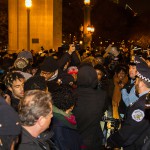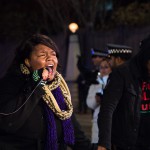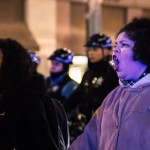By Misha Euceph, Max Greenwood,
Patrick Martin and Raquel Zaldivar
More than 100 protesters took to the streets of Chicago on Tuesday, after the release of a video that shows a white police officer shooting a black teenager 16 times, ushering in the first of many expected demonstrations across the city.
The protest started at the intersection of Roosevelt Road and Halsted Street less than two hours after Mayor Rahm Emanuel and Chicago Police Superintendent Gary McCarthy announced the release of a police dash-cam video of officer Jason Van Dyke unloading 16 shots into 17-year-old Laquan McDonald.
A Cook County judge ordered the video’s release last week, giving city officials until Wednesday to make it available to the public, after a Chicago-based freelance journalist filed a lawsuit to obtain the video.
Earlier Tuesday, Van Dyke was charged with first-degree murder, and a judge ordered that he be held without bail until the following Monday at the earliest.
Related Stories
The Laquan McDonald case: A timeline of the past year
In Chicago, a murder charge and a police video as a city holds its breath
City releases dash-cam video of 2014 slaying of black teenager
“16 shots” echoed as protestors took to Chicago’s streets (video)
“The officer in this case took a young man’s life, and he’s going to have to account for his actions, and that’s what today is all about,” McCarthy said, also urging potential protesters to keep demonstrations peaceful.
Several people were arrested after Tuesday night’s protests, however. The demonstration reached a critical stage at the intersection of Roosevelt and State, where marchers stopped and formed a circle. They held hands and chanted various phrases, including, “The police are a gang!;” “you don’t need no pension when y’all get paid for lynchin’;” and “they think this is a joke, they think this is a game.”
The Protest Route
[field name=”McDonald protest map”]
Three Chicago-based groups–Black Youth Project 100, Assata’s Daughters and We Charge Genocide–organized the Tuesday evening protest protest with the help of other grassroots organizations, first announcing it through a Facebook event after the press conference held by McCarthy and Emanuel.
Although most black protesters declined to talk to media, some people who joined the protests later expressed their support for the sentiment.
“We’re hoping to gain more exposure to the problems that are happening on the South and West sides. It’s like things like this happen on a day to day basis.” said Delroy Taylor, a black Chicago resident and a participant in the protest. “The accumulation of things that are happening is leading to this today.”
[vimeo 146968603 w=500 h=281]
The demonstrators attempted to enter Grant Park, with some confronting law enforcement. Police blocked protesters from entering the park by creating a barricade of bicycles and arrested a handful of protesters, stating that a few became aggressive and grabbed at the officers’ bikes.
In the midst of arrests, people yelled, “They took three!” Police arrested Troy Alim, 24; Johnae Strong, 25; and Page May, 26, during the protest and later released them.
Malcolm London, 22, a protester and local activist, was arrested later in the night and charged with aggravated battery to a police officer. The charges were dropped Wednesday, after members of the Chicago City Council Black Caucus called for London’s release, saying the accusations were exaggerated and that he had acted within the law.
Several reportedly injured protesters claimed that officers had pushed them. Many left the frontlines of the protest crying, leaning on others and refusing to speak to media or police.
“The racial climate between minorities and cops is very bad,” said Steven Phillips, a black Chicago resident who observed the protest from outside the circle. “But I don’t want to see the city go up in flames like a Baltimore or like a Ferguson.”










